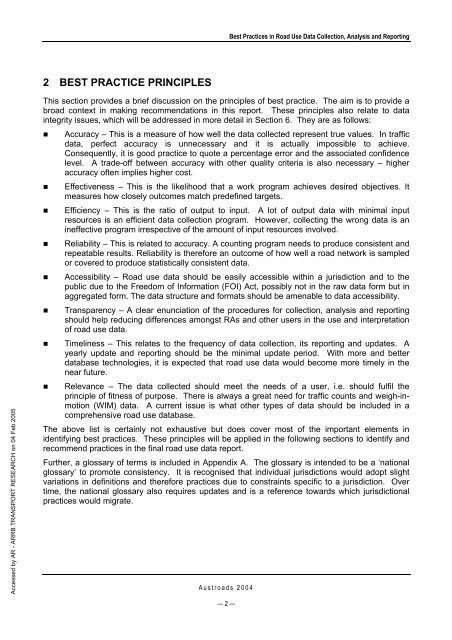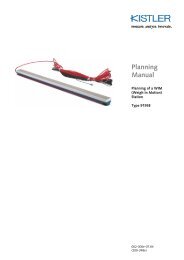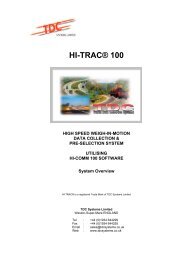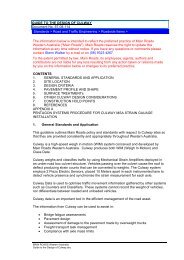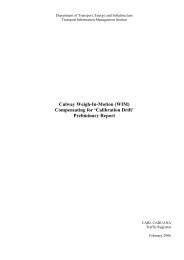AP-G84/04 Best practice in road use data collection, analysis ... - WIM
AP-G84/04 Best practice in road use data collection, analysis ... - WIM
AP-G84/04 Best practice in road use data collection, analysis ... - WIM
Create successful ePaper yourself
Turn your PDF publications into a flip-book with our unique Google optimized e-Paper software.
Accessed by AR - ARRB TRANSPORT RESEARCH on <strong>04</strong> Feb 2005<br />
2 BEST PRACTICE PRINCIPLES<br />
Aust<strong>road</strong>s 20<strong>04</strong><br />
— 2 —<br />
<strong>Best</strong> Practices <strong>in</strong> Road Use Data Collection, Analysis and Report<strong>in</strong>g<br />
This section provides a brief discussion on the pr<strong>in</strong>ciples of best <strong>practice</strong>. The aim is to provide a<br />
b<strong>road</strong> context <strong>in</strong> mak<strong>in</strong>g recommendations <strong>in</strong> this report. These pr<strong>in</strong>ciples also relate to <strong>data</strong><br />
<strong>in</strong>tegrity issues, which will be addressed <strong>in</strong> more detail <strong>in</strong> Section 6. They are as follows:<br />
Accuracy – This is a measure of how well the <strong>data</strong> collected represent true values. In traffic<br />
<strong>data</strong>, perfect accuracy is unnecessary and it is actually impossible to achieve.<br />
Consequently, it is good <strong>practice</strong> to quote a percentage error and the associated confidence<br />
level. A trade-off between accuracy with other quality criteria is also necessary – higher<br />
accuracy often implies higher cost.<br />
Effectiveness – This is the likelihood that a work program achieves desired objectives. It<br />
measures how closely outcomes match predef<strong>in</strong>ed targets.<br />
Efficiency – This is the ratio of output to <strong>in</strong>put. A lot of output <strong>data</strong> with m<strong>in</strong>imal <strong>in</strong>put<br />
resources is an efficient <strong>data</strong> <strong>collection</strong> program. However, collect<strong>in</strong>g the wrong <strong>data</strong> is an<br />
<strong>in</strong>effective program irrespective of the amount of <strong>in</strong>put resources <strong>in</strong>volved.<br />
Reliability – This is related to accuracy. A count<strong>in</strong>g program needs to produce consistent and<br />
repeatable results. Reliability is therefore an outcome of how well a <strong>road</strong> network is sampled<br />
or covered to produce statistically consistent <strong>data</strong>.<br />
Accessibility – Road <strong>use</strong> <strong>data</strong> should be easily accessible with<strong>in</strong> a jurisdiction and to the<br />
public due to the Freedom of Information (FOI) Act, possibly not <strong>in</strong> the raw <strong>data</strong> form but <strong>in</strong><br />
aggregated form. The <strong>data</strong> structure and formats should be amenable to <strong>data</strong> accessibility.<br />
Transparency – A clear enunciation of the procedures for <strong>collection</strong>, <strong>analysis</strong> and report<strong>in</strong>g<br />
should help reduc<strong>in</strong>g differences amongst RAs and other <strong>use</strong>rs <strong>in</strong> the <strong>use</strong> and <strong>in</strong>terpretation<br />
of <strong>road</strong> <strong>use</strong> <strong>data</strong>.<br />
Timel<strong>in</strong>ess – This relates to the frequency of <strong>data</strong> <strong>collection</strong>, its report<strong>in</strong>g and updates. A<br />
yearly update and report<strong>in</strong>g should be the m<strong>in</strong>imal update period. With more and better<br />
<strong>data</strong>base technologies, it is expected that <strong>road</strong> <strong>use</strong> <strong>data</strong> would become more timely <strong>in</strong> the<br />
near future.<br />
Relevance – The <strong>data</strong> collected should meet the needs of a <strong>use</strong>r, i.e. should fulfil the<br />
pr<strong>in</strong>ciple of fitness of purpose. There is always a great need for traffic counts and weigh-<strong>in</strong>motion<br />
(<strong>WIM</strong>) <strong>data</strong>. A current issue is what other types of <strong>data</strong> should be <strong>in</strong>cluded <strong>in</strong> a<br />
comprehensive <strong>road</strong> <strong>use</strong> <strong>data</strong>base.<br />
The above list is certa<strong>in</strong>ly not exhaustive but does cover most of the important elements <strong>in</strong><br />
identify<strong>in</strong>g best <strong>practice</strong>s. These pr<strong>in</strong>ciples will be applied <strong>in</strong> the follow<strong>in</strong>g sections to identify and<br />
recommend <strong>practice</strong>s <strong>in</strong> the f<strong>in</strong>al <strong>road</strong> <strong>use</strong> <strong>data</strong> report.<br />
Further, a glossary of terms is <strong>in</strong>cluded <strong>in</strong> Appendix A. The glossary is <strong>in</strong>tended to be a ‘national<br />
glossary’ to promote consistency. It is recognised that <strong>in</strong>dividual jurisdictions would adopt slight<br />
variations <strong>in</strong> def<strong>in</strong>itions and therefore <strong>practice</strong>s due to constra<strong>in</strong>ts specific to a jurisdiction. Over<br />
time, the national glossary also requires updates and is a reference towards which jurisdictional<br />
<strong>practice</strong>s would migrate.


